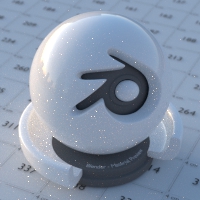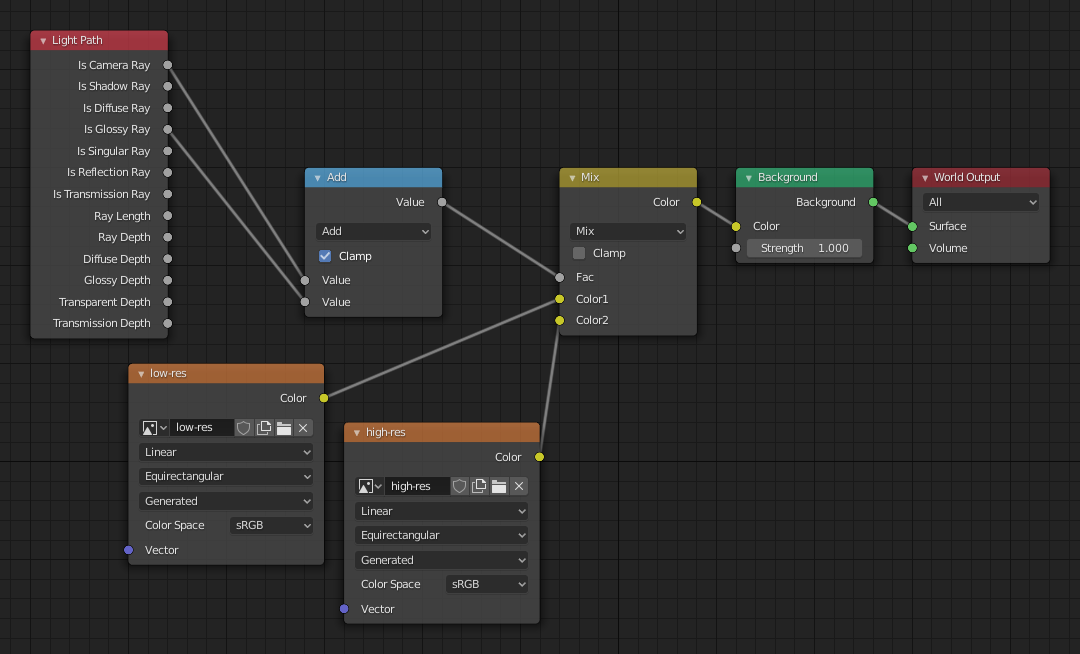World Settings¶
Ambient Occlusion¶
Справка
- Panel
Ambient occlusion is a lighting method based on how much a point on a surface is occluded by nearby surfaces. It simulates soft global illumination shadows by faking darkness perceived in corners and at mesh intersections, creases, and cracks, where ambient light is occluded, or blocked. This is a trick that is not physically accurate, but it is useful to emphasize the shapes of surfaces, or as a cheap way to get an effect that looks a bit like indirect lighting.
- Factor
The strength of the ambient occlusion; value 1.0 is like a white world shader.
- Distance (расстояние)
Расстояние от точки затенения для трассируемых лучей. При маленьком расстоянии на затенение влияют только близлежащие объекты, а при большом принимаются во внимание так же и те, что находятся дальше.
Lighting from ambient occlusion is only applied to diffuse reflection BSDFs; glossy or transmission BSDFs are not affected. Transparency of surfaces will be taken into account, i.e. a half-transparent surface will only half occlude.
An alternative method of using Ambient Occlusion on a per-shader basis is to use the Ambient Occlusion shader.
Проход тумана¶
Справка
- Panel
Примечание
The mist pass must be enabled in the View Layer tab of the Properties Editor before the settings below are available in the World tab.
Mist can greatly enhance the illusion of depth in your rendering. To create mist, Blender generates a render layer with a depth map ranging between 0.0 and 1.0 that can be used in the Compositor to generate a mist effect.
- Start (начало)
The distance from the camera at which the mist starts to fade in.
- Depth (глубина)
The distance from Start of the mist, that it fades in over. Objects further from the camera than Start + Depth are completely hidden by the mist.
- Спад
The curve function that controls the rate of change of the mist’s strength further and further into the distance.
- Quadratic (квадратично)
Uses the same calculation as light falloff (\(1\over{x^2}\)) and provides the smoothest transition from transparent (0.0) to opaque (1.0).
- Linear (линейно)
Has a steeper start than quadratic (\(1\over{x}\)).
- Inverse Quadratic
Has the steepest start (\(1\over{\sqrt{x}}\)) and approaches 1.0 faster than the other two functions.
Совет
A visualization can be activated in the panel.

Mist example (blend-file).¶
Settings¶
Справка
- Panel
Surface (поверхность)¶
- Sampling
Controls the sampling method for the world material. Selecting Auto or Manual enables Multiple Importance Sampling while None disables it. Multiple Importance Sampling is a method to sample the background texture such that lighter parts are favored, creating an importance map. It will produce less noise in the render in trade of artifacts (Fireflies). Enable this when using an image texture with small area lights (like the sun), otherwise noise can take a long time to converge.
Below is a comparison between Multiple Importance Sample off and on. Both images are rendered for 25 seconds (Off: 1,500 samples, On: 1,000 samples).

Multiple Importance Sample off.¶

Multiple Importance Sample on.¶
- Разрешение карты
Sets the resolution of the importance map. A higher resolution will better detect small features in the map and give more accurate sampling but conversely will take up more memory and render slightly slower. Higher values also may produce less noise when using high-res images.
- Макс. отскоков
Максимальное количество отскоков для лучей света от фона, вносящих свой вклад в итоговую визуализацию.
См.также
Дополнительную информацию по снижению шумов смотрите в разделе Уменьшение шума.
Volume (объём)¶
- Сэмплирование объёма
- Distance (расстояние)
For dense volumes lit from far away Distance sampling is more efficient in most cases. Usually this shouldn’t be used for World volumes.
- Равноугольно
Если у вас внутри или вблизи объёма есть источник света, то лучше равноугольная выборка.
- Множественная значимость
Если у вас комбинация и того, и другого, то лучше будет множественная выборка по значимости.
- Interpolation
Метод сглаживания (интерполяции) для объёма.
- Linear (линейно)
Simple interpolation which gives good results for thin volumes.
- Cubic (кубический)
Smoothed high-quality interpolation needed for more dense volumes, but slower.
- Homogeneous Volume
Assume volume has the same density everywhere (not using any textures), for faster rendering. Usually this is automatically determined by the renderer. This settings provides a manual control for cases where it is not detected.
- Размер шага
Distance between volume shader samples for world volume shaders. See Volume Render Settings for more information.
Видимость лучей¶
Справка
- Panel
Как и с другими объектами, панель Видимость лучей позволяет вам контролировать, какие шейдеры смогут «увидеть» окружение.
Хитрости¶
Sometimes it may be useful to have a different background that is directly visible versus one that is indirectly lighting the objects. A simple solution to this is to add a Mix node, with the Blend Factor set to Is Camera Ray. The first input color is then the indirect color, and the second the directly visible color. This is useful when using a high-res image for the background and a low-res image for the actual lighting.
Аналогично, добавив сокеты Луч из камеры и Луч глянца, изображение с высоким разрешением будет так же видно и в отражениях.

Узлы для вышеописанной хитрости.¶